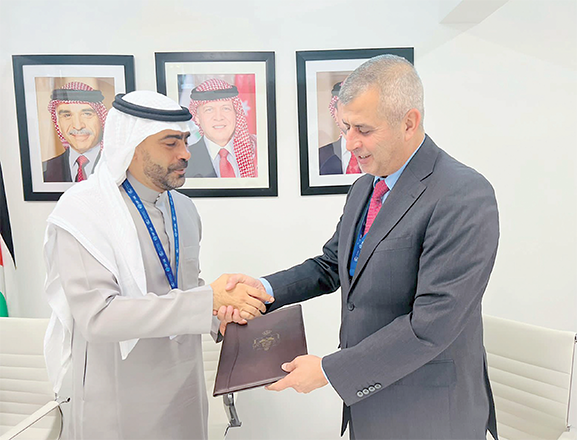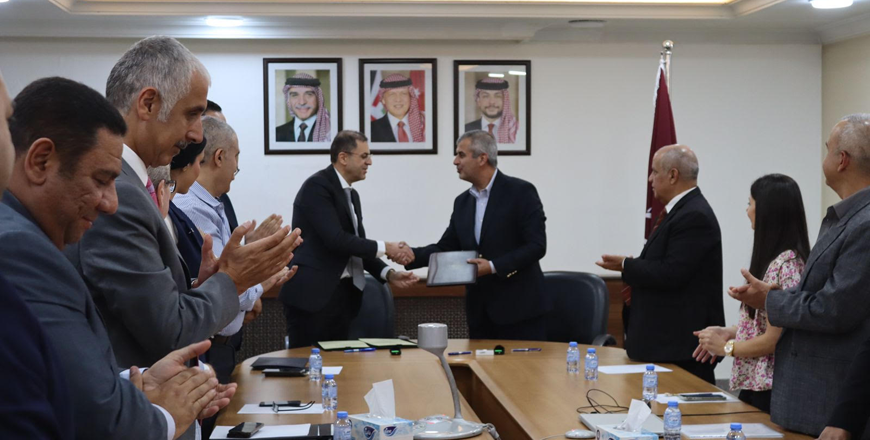You are here
Jordan takes strides towards green ammonia production with four key MoUs
By Mays Ibrahim Mustafa - Nov 15,2023 - Last updated at Nov 15,2023
AMMAN — Minister of Energy and Mineral Resources Saleh Kharabsheh on Monday signed four memorandums of understanding (MoUs) to prepare feasibility studies aimed at developing a production capacity of green ammonia in Jordan equal to up to 1.5 million tonnes annually.
Parties to the signing included CEO of Kawar Energy Hanna Zaghloul, CEO of Philadelphia Solar Energy Abdulrahman Shehadeh, CEO of the Irish Amarenco Group Yazan Faouri, and CEO of the German company Enertrag, Gunar Hering.
The MoU with Kawar Energy aims to generate 100,000 tonnes of green ammonia annually, and the MoU with Philadelphia Solar aims to generate 100,000 to 200,000 tonnes of green ammonia annually, the Jordan News Agency, Petra, reported.
The MoU with Enertrag aims to produce around 200,000 tonnes of green ammonia every year, while Amarenco will be producing around 1 million tonnes of green ammonia annually, according to Petra.
Kharabsheh noted during the signing that three other MoUs for green hydrogen production in Jordan were previously signed.
He added that the ministry will sign five more similar MoUs, during the 2023 United Nations Climate Change Conference, also referred to as COP28, which is going to take place at the end of this month in the United Arab Emirates.
Kharabsheh noted that Jordan aims to take on a leading regional role in green hydrogen production, in light of the executive plan for the Jordan Economic Modernisation Vision (2020-2023), which encourages investments in that area.
The minister also highlighted Jordan’s achievements in the field of renewable energy. He pointed out that the share for renewables in total power generation capacity in Jordan reached 27 per cent in 2022.
The ministry had previously revealed government plans to revisit the the Energy Strategy for the Energy Sector 2020-2030, and increase its target for the share of renewable energy contribution to electricity generation from 31 to 50 per cent by 2030.
Green hydrogen to support transition towards clean energy
Speaking with The Jordan Times, Ayoub Abu Dayyeh, a civil engineer and specialist in environmental sustainability, highlighted the potential for green hydrogen production in Jordan, as well as possible challenges along the way.
He noted that green hydrogen is “almost” a CO2-free source of fuel, generated using renewable energy sources, which makes it a sustainable and environmentally friendly alternative to fossil fuels.
Abu Dayyeh also pointed out that Hydrogen, as an energy carrier, is considered an essential element of the transition to clean energy.
He explained that an “amble” amount of solar power is produced during the day, compared with zero production when the sun goes down, which requires using gas or other fossil fuels to cover needs during the night.
“The clean alternative to this is producing green hydrogen using energy from renewable sources during the day; this makes it possible to store surplus renewable energy in hydrogen and use it to produce zero-carbon fuel,” he added.
Economic feasibility
Abu Dayyeh said that the main reason why Green hydrogen has become an attractive investment is that renewable energy prices have dropped “dramatically” over the past few years, which makes producing hydrogen very “feasible”.
He added that green hydrogen plays a role in limiting carbon emissions, meaning that it can help tackle climate change challenges in Jordan and around the world. This in turn offers the opportunity to make use of green funds to further investment in this area.
He noted that there’s local and global policy support for climate change mitigation and adaptation, as well as technological advancements, reducing the cost of producing green hydrogen, in addition to technical advancements in electrolysis.
Abu Dayyeh also views the fact that Jordan is dealing with a “surplus” in energy production and the fast-growing global electricity demand are contributing factors to the feasibility of investing in green hydrogen.
For example, the demand for energy in Europe is expected to increase during winter, as the Russian gas tap remains closed, he said.
Storage remains ‘key’ challenge for Jordan
Water scarcity in Jordan is not a major challenge in the production of green hydrogen, because it’s possible to desalinate sea water in the Gulf of Aqaba, “taking into consideration the environmental impact of the project on biodiversity”, according to Abu Dayyeh.
However, he stressed the importance of implementing clear and specific legislations in this area, in addition to providing incentives for investors to support the transition of industries into green hydrogen, such as offering tax exemptions and seeking buyers to market hydrogen.
He added that storage remains a “key challenge” in harnessing Jordan’s full potential in renewable energy. That’s why it’s necessary for the government to invest in infrastructure for hydrogen based on a long-term strategy that covers the period until 2050.
Related Articles
AMMAN — Memoranda of Understanding (MoUs) signed during COP28 in the field of green hydrogen and green ammonia are set to usher a new era of
AMMAN — Minister of Energy and Mineral Resources Saleh Kharabsheh on Tuesday signed a memorandum of understanding (MoU) with Chairman of Mas
AMMAN — The Ministry of Energy and Mineral Resources and Tajanus Company signed two memoranda of understanding to conduct evaluation studies


















